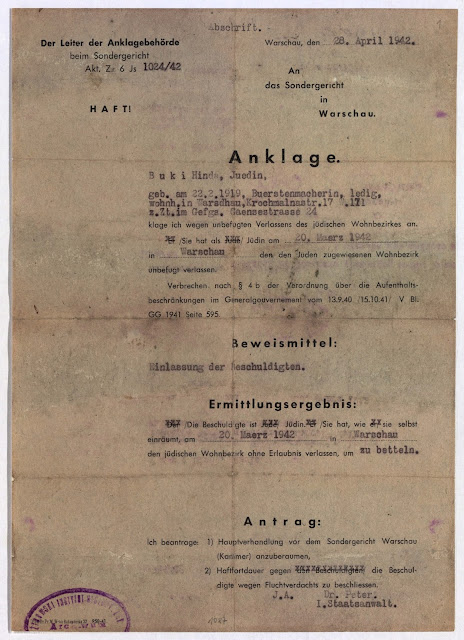 |
| The Warsaw ghetto footbridge |
Here is the third document we were given:
Dr. Jan Grabowski's translation from Polish:
Verso
of the postcard:
21/XII/42
To the Council of Elders
Please, let me know where is my son, Izak
Micner, post office employee.
If he is not there, please let me know where he
is.
I know that you will not refuse [my request].
Written by the desperate father
Recto
of the postcard:
Sender: M. Micner Recipient: Council of Elders
Schultz Factory Turobin,
Krasnystaw area
Tailors’ shop
Nowolipki 29
Your son Izaak Micner departed for the bosom of
Abraham.
He has been killed
Council of Elders
___________________________________________________________________________________
Here's what I uncovered on this one:
Izak Micner: Listed
on the Yad Vashem database as Yitzkhak Micner, he is described as a fourteen
year-old boy from Turobin, Poland. In the document itself, his father indicates that Izak was a post-office
employee in that village.
M. Micner (Mordachaj Micner): According to the Yad Vashem database, Mordachaj Micner
was forty years old when he wrote the postcard. He was married to a woman named Alte, and had been a merchant in Turobin. He identifies himself in the postcard as an employee of the Schultz Factory’s
tailors’ shop in the Warsaw ghetto, and according to the database he was killed
a year later (1943) in the Izbica camp, Poland.
Schultz Factory: The German apparel manufacturing company-owned by Fritz Emil Schultz was
granted official designation as a war production firm by the German High
Command in the fall of 1940. Due to his longstanding ties with the Jewish community, he chose the Warsaw
ghetto as the site of his operations to produce winter clothing for the German
army, which opened in September 1941. At its peak in July 1942, the factory employed nearly 4,500 Jewish laborers.
 |
| Jews at work in the textile section of the Schultz Factory |
Council of Elders: Chief of the Reich Central
Security Office Reinhard Heydrich gave a conference in Berlin on 21
September1939 at which, after describing the ‘ultimate aim’ to concentrate
Polish Jews in large cities, he called for a Council of Jewish Elders to be
established in each city. These councils were to be responsible for ensuring that the movements of Jews
were carried out on time, and they were threatened with the ‘severest measures’
in case of ‘sabotage of such instructions.’
Much like the second
document, this source represents the ways in which family members were
separated and lost contact with each other as the German regime moved people
around in mass numbers. Since issues of spelling and poor records make it
nearly impossible to establish these claims as certain facts, I, much like the
Turobin Council of Elders, was unable to provide a concrete description of the
circumstances surrounding Izak Micner’s death. However, if the information from
the Yad Vashem database can be taken as truth (I was unable to find a list of
Schultz factory employees which would verify this as his name), more can be
answered about the fate of the desperate father who wrote this postcard. In the
late summer and fall of 1942, massive transportations to Treblinka decimated
the factory’s workforce, but Mordachaj Micner evidently escaped these. The firm continued operating until February 1943, when it was transferred in
stages to the Trawniki concentration camp, and maintained production until the
entire camp population was liquidated during the Harvest Action on 3 November,
1943.Since the Yad Vashem database lists his death year as 1943, it is therefore likely
that he perished in this Aktion.
Works Cited
Gilbert, Martin. The Holocaust: The Jewish Tragedy. London:
William Collins Sons & Co. Ltd.,
1986.
United States Holocaust
Memorial Museum. “Work permit issued by the Schultz Company to
Gina
Tabaczynska.” Accessed 3 February 2016.
http://digitalassets.ushmm.org/photoarchives/detail.aspx?id=1087269.
Yad Vashem The Holocaust
Martyrs' and Heroes' Remembrance Authority. “The Central
Database of Shoah Victims’ Names.” Accessed 3 February
2016.
firstName=Izak&s_place=&itemId=8852909&ind=3.
Thanks for reading,
Delany Leitch (@DLeitchHistory on Twitter!)















